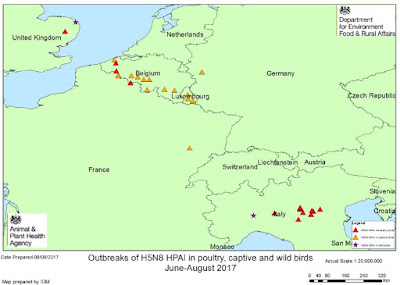#12,673
While Europe's unprecedented HPAI H5 epizootic ended in the spring we continue to see a smattering of H5N8 outbreaks in poultry, or detections in wild birds, across a wide swath of the continent. Over the past 60 days we've seen more than 30 such reports, from Italy, Belgium, Luxembourg, France, and the UK.
Today the UK's DEFRA has published an update which details these recent events, and reminds us that the virus remains at low levels in the environment and in local birds.While the overall risk level for the UK is currently stated as LOW - the annual fall return of migratory birds is expected to begin next month - and nobody can predict what that will bring.
Updated Outbreak Assessment #16Some recent blogs on HPAI H5N8 in Europe include;
Highly Pathogenic Avian Influenza H5N8 in the UK and Europe
8th August 2017 Ref: VITT/1200 Avian Influenza in UK & Europe
Disease report
Since our last update to the OIE 1st June 2017, H5N8 HPAI has been confirmed in the UK in a wild mute swan in Norfolk. The swan was found dead and reported as part of our active wild bird surveillance programme on the 26th July at a wildlife reserve (OIE, 2017a). There have been no cases in poultry since the last outbreak in June in a backyard flock in South Norfolk, which was resolved quickly with no further spread detected. Epidemiological reports into the UK outbreaks between November 2016 and June 2017 are available at: https://www.gov.uk/government/publications/reports-relating-to-recent-cases-of-avian-influenza-bird-flu
In Europe, reports of H5N8 HPAI have continued in a number of countries. Since the 19th July, Italy has reported twelve outbreaks of H5N8 HPAI: three in the Verona region, seven in Mantova, one in Lombardy and one in Parma. All were in fattening turkeys except for one outbreak in Mantova that was in layer hens and one in Lombardy in geese, just 50 km from a recent wild bird finding (OIE, 2017b).
There have been 10 outbreaks in captive birds and 2 in poultry in Belgium. Luxembourg also reported disease for the first time this season, in four captive bird holdings, while France also reported a single outbreak in a holding just over the border from Belgium. All of these outbreaks were associated with dealers selling birds through markets in Belgium, according to the report on the European Commission website (EU PAFF, 2017).
Elsewhere, the H5N8 HPAI virus also continues to be reported in South Africa and Democratic Republic of Congo. The outbreaks reported in Zimbabwe have been rapidly controlled and not led to further spread. In South East Asia other avian influenza serotypes continue to be reported, including H5N1, H5N2, H5N6 as well as H5N8. Russia has just recently reported an outbreak in backyard poultry in Moscow region.
Situation assessment
The presence of virus in a mute swan in Norfolk confirms that disease has continued to circulate as expected at a very low level in resident wild waterfowl for several months, as it is considered very unlikely this bird is anything other than a resident bird. It is certain that the H5N8 virus has not gone away and therefore in the coming months all Member States may see more outbreaks in poultry and cases in wild. For the UK, the main migratory season for overwintering wild waterfowl will usually start in September with some of the early arrivals, and with a peak occurring between November and February.
In terms of the other EU MSs, the cases in Belgium, France and Luxembourg were all associated with contact through markets and this reinforces the issue of allowing unlicensed gatherings and markets to take place when the risk of avian influenza is increased. The cases in Italy are still under investigation but given the close proximity to each other and that most are the same type of poultry, there may have been some common contact which has spread disease locally; three of the fattening turkey holdings were within the 10km PZ of the positive layer hen holding.
Conclusion
The overall risk level for the UK is considered to be “LOW”, which is our normal year-round background risk level, given avian influenza viruses are usually circulating at a low level in wild waterfowl. The new finding in North Norfolk does not change that risk level. Therefore, the risk for poultry also remains “LOW” for introduction of infection onto individual premises, but will depend on levels of biosecurity.
We strongly recommend that all poultry keepers (including backyard keepers) review their biosecurity measures and business continuity plans now, as the risk level may well increase in the coming weeks. They should familiarise themselves with government guidance on good biosecurity and how to report suspicion of disease appropriately.
Further information is available here: https://www.gov.uk/guidance/avian-influenza-bird-flu including updated biosecurity advice for poultry keepers for England; http://gov.wales/topics/environmentcountryside/ahw/poultry/bird-gatherings-advice/?lang=en for Wales and; http://gov.scot/avianinfluenza for Scotland
We ask that the public use the Defra helpline (Tel: 03459 33 55 77) to report findings of dead wild birds. In particular, any wild ducks, wild geese, swans, gulls or birds of prey and where more than five birds of any species are found dead in the same location.
Italy: IZSV Confirms 4 More H5N8 Outbreaks In Poultry
ESA Epidemiological Update: HPAI H5 Clade 2.3.4.4 Viruses In Europe
France: MOA Reports HPAI H5N8 In Brillon
Belgium Reports Their 12th H5N8 Outbreak Of June
